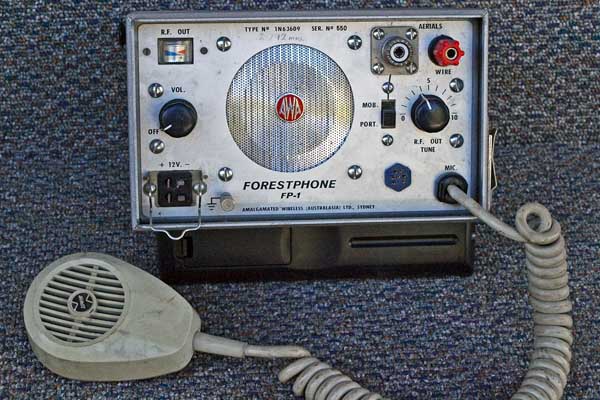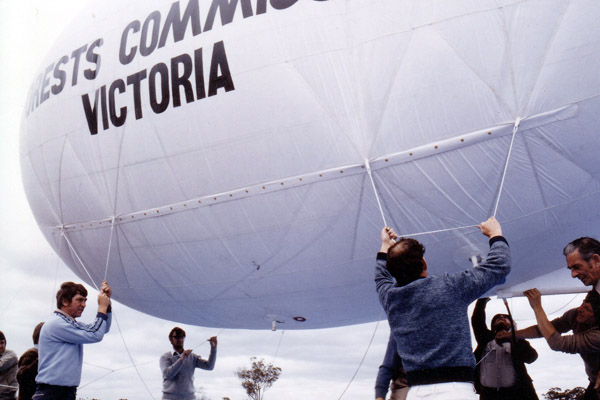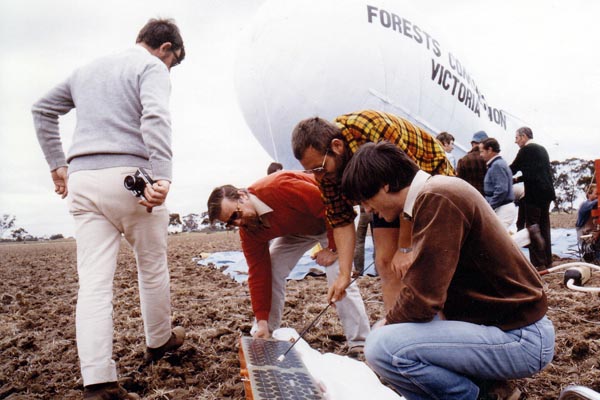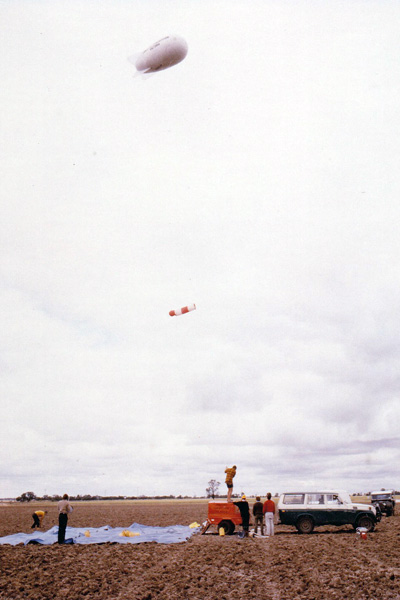Wesley 'Rex' Philpot
Written by Rex in 2002
My first introduction to “Wireless” was in 1924 when one of my Uncles let me hear music from a pair of headphones laying in a bowl of some sort, I have never forgotten it. This was in England, but when we arrived in Australia, in 1926, it was very rare to find a wireless, and those that did exist were crude TRF receivers usually always with a separate tuning ‘condensor’ for each one, two, or three tuned circuits.
Valves filaments (heaters) were supplied with DC from lead acid accumulators, and the local Motor Garage usually made quite an income from the charging of (usually) 2 volt batteries.
My Father purchased a wireless set from a man, who was obviously a ‘back yarder’, which if you stuck your ear in to the horn of the speaker did imitate the very weak sound of music. We lived in Kyabram, about 100 miles from Melbourne, so the ‘waves’ had a long way to come. It was very unsatisfactory despite the great length of wire hanging up outside.
I think that it was in about 1929 that A.W.A. produced a real wireless - the Radiola 45E. We were the first in the town with one, and if it was turned up, you could hear it outside. It had three tuned stages with 227’s and a triode output 245. Power supply rectifier a 280, can’t remember what the Detector was. The speaker was a big 10 inch and its field was excited by using the field winding as a power filter choke with two very wet electrolytics.
I think that it was basically at this time I became fascinated by the art, but being only 10 years old there was nothing I could do except tune around when there was no one at home to see if there were other stations. I did hear foreign voices at the high end, and morse code at the low end, and if Father had caught me doing this it would have been goodnight Wesley.
I think it was about 1931 when we moved to East Kew, Strathalbyn Street. Dad had purchased a bakery business there. My sister’s fiancé gave her a crystal set, and this re-created my interest in wireless. Before long I had begged, borrowed or stolen a detector which I think was named ‘Red Diamond’. A cardboard tube wound with copper wire having a scraped strip exposing the copper allowing a brass contact to be positioned and in contact with the windings was all that was necessary. I can remember hearing on Sunday mornings amateur stations playing music. I think that the one I heard quite often was VK3FW, I believe to be Bill Fulton, his trade mark seemed to be tapping on his microphone with a pencil. Apparently there was a special dispensation for approved amateurs to operate Sunday mornings. I have a very faint recollection that a VK3AK became a commercial station known as the AKRON TYRE station.
I found that connecting an aerial to one side of a buzzer contact, I could send morse and receive it strongly on my crystal set, unfortunately neighbours complained bitterly that all the stations they wanted to listen to had beep-beep on them.
My big break came when someone gave me four old battery valves. I think they were B406’s. At the same time I received a ‘Battery Eliminator’. I was on my way, Marconi eat your heart out.
A borrowed ARRL [American Radio Relay League (Ed.)] handbook described a transmitter referred to as a T.P.T.G. (tuned plate, tuned grid) and using one of the B406’s I soon had a contraption on a bit of wood that made a pea lamp glow when coupled to the tank with a loop. Oh! how wonderful. No one who has not done this the hard way will know just what the fascination was.
Next was the information probably from the same ARRL handbook that a carbon microphone hooked via a loop coupled to the tank coil will modulate the carrier. But I had no microphone. A redgum block with a rectangular recess cut into the face, two brass screws with their heads protruding from the recess to the back of the block with a sheet of thin mica stuck on the front. A piece of charcoal pounded into fine particles, and the resulting fine granules were poured into the recess. It worked but sounded bloody terrible, and obviously some improvement was essential.
I still had two B406’s left, one as a pre-amp, and one as a modulation stage, an old choke as a modulation inductance and ‘hey presto’ speech sounded good on my old crystal set, but something had to be done about a receiver. Kids didn’t have money in those days, and I was no exception so a B406 as a regenerative receiver was it. Most people today would be amazed to hear the signals that were copied on this toy at that time of relatively clean spectrum.
By this time I became friends with a couple of other young bounders who were also as interested as I. We made plans and, to cut a long story short, one night I switched on the ‘rig’ and started calling, at the same time I was fiddling with the aerial link to the tank (remember it was a TPTG). When I went to receive and started to search somewhere on 80m I heard a weak voice saying “Yes I can hear you, but for Pete’s sake stay in the one spot”…..I was a Pirate….
I had a lot of fun with my crude gear, like hiding the mic. behind the piano and going to a mate’s place to listen to the family’s conversation, it was at times very enlightening.
Next to where we lived (above the shop) was a Motor Garage. Saturdays were SP bookie day. I should mention here that one of the naughty things I used to do was: connecting my transmitter to the output of our broadcast receiver and walking around the vicinity with a matchbox crystal receiver and headphones. Reception was excellent within about 200 yards. I mentioned to the SP bookie that I could get the race results, and he bet me five shillings that I couldn’t. I won the five shillings.
Because of my exposed location I was cunning enough to realize that my antenna could be seen plainly from the lane. I remedied this very early when I became illegal by using very fine wire for the antenna, the sort of wire that PMG earphones were wound with (and I’m admitting nothing); this was invisible unless you were aware of where to look, but it did annoy me by breaking often.
From here the illegal transmissions flourished, we were on nearly every night and I won’t mention the call-signs we used; but all good things come to an end. One night my mate’s brother arrived at my place puffing, threw his bike down and gasped, “The RI’s got Bert and Frank, get rid of your gear”.
Well the gear went over next door’s fence and I waited and waited in fear, but no RIs arrived, Bert and Frank had refused to tell them my address.
Bert and Frank copped a 30-shilling fine and their gear confiscated. That tamed us a bit and it was decided that if we wanted to continue an Amateur qualification was essential. I was a working apprentice about 16 or 17 yrs of age, and did find it possible to scrape up enough money to purchase a few bits and pieces. First a ‘JONES SUPERGAINER’ courtesy the ARRL handbook. I thought this a wonderful little receiver, it’s squegging regeneration gave it enormous gain, but it did radiate with no RF stage.
I obtained my license and was issued with the callsign VK3EZ.
Started with a 6L6G Xtal Osc and stuck with CW for a while. When I rang ‘Bright Star’ to order a Xtal the man (I can’t remember his name) said “Yeah, I’ve heard your note and didn’t think it would be long before you wanted to go Xtal control”.
It wasn’t long before I followed the gang with 807 PA, 6V6 buffer, 6V6 CO modulated by a pair of 6V6s with a D104 mike.
My brother and I joined the 2nd Division Signals Militia Unit and at the outbreak of war went into training camp at Broadmeadows. It didn’t take long for me to decide that I knew more than the instructors, so transferred to the RAAF. I was accepted as Group 1 Sergeant W.E.M. (Wireless and Electrical Mechanic), Serving first with 22 sqdn (Richmond), 10 sqdn Plymouth (UK), 461 sqdn (Pembroke Dock), 463 sqdn (Driffield). I served a total of 6yrs and 4 months with the RAAF.
Subsequent to discharge and some job and soul-searching, I commenced duty as a Senior Technician with the P.M.G’s Research Laboratories, and was employed in design and manufacture of the equipment to be used for path survey between Mt Oberon (Wilson’s Promontory) and Mt Stanley (Tasmania).
We camped at Wilson’s Prom. and carried equipment up to the top of Oberon on our backs, including motor generators. We erected the mast and yagis and set up tents ready to commence transmission next day. It started to blow and we arrived at the top just in time to see masts come down and one tent flying down into the valley. But the job did get done, and the only signal dropout I can recall was during a display of Aurora Australis, and this was not for very long. But the heavy work took a toll on me and I was hospitalized for a hernia operation. It was light duties for a while and I was seconded to the Mont Park Monitoring Station as an operating Monitor. I was at this time qualified for 25 wpm morse.
I’ve lost count of time, but I spent a few years here, qualified as Radio Inspector. Mont Park eventually became far too noisy and I was given the job of investigating suitable sites with a view of rebuilding the Monitoring Station.
I scrounged some hydrogen balloons from the Weather Bureau and used them to lift vertical wires instead of having to erect expensive masts. They did the job and a site on a hill at South Morang was approved and building carried out. I continued there monitoring and frequency measuring under the Officer in Charge who at the time was Alf Avard. But I did break out in a sweat when one balloon broke away dragging 100 feet of antenna wire and drifted west toward the high tension transmission lines at the bottom of the hill. Lucky for me it gracefully rose and cleared the lines by at least a 100 feet. Gee I could see myself doing a stretch for that one, but it would have been spectacular as I believe the line carried 200kv.
I would like to insert a short story here. Alf Avard, Chief Inspector - Wireless Branch was talking casually to me one day, when the subject of ‘pinching’ Pirates came up. It turned out that he was the Officer who investigated the illegal transmissions from Bert, Frank and myself. I asked him how was it that I wasn’t prosecuted. He replied that he knew I was guilty and referred to me in uncouth terms, saying that he spent hours looking around our place but could find no aerial, while Bert and Frank had elaborate and obvious ones. Wasn’t I smart to use very fine wire?
Somewhere about 1964 I was appointed to the position of Communications Officer of the Forests Commission of Victoria.
At this time Forests communications were not crash hot, and when I saw what faced me I was somewhat dismayed. Crude base antennas with single wire 600-ohm feed!!! Folded sometimes to make them fit in. Portable radios with dry batteries, mobile radios with helical antennas that at least 6 feet long whacked against every low bough. Base radios that were not even crystal locked to Base frequency.
Luckily the Chief Fire Protection Officer (at that time Ted Gill) agreed with me that the system was in a mess, but I was aghast when he directed me to put all my resources into the development of portable transceiver for operation in the 2 to 5 M/hz band and for this unit to be transistor equipped.
I replied that he was not asking me for a development rather an invention as no one yet had been able to produce large amounts of RF power from a transistor without puncturing the transistor’s junction. We urgently imported a couple of units from U.S.A. via a local Agent which claimed to produce an output of 5 watts. Test results: they both blew finals immediately the antennas looked like being mismatched. A fat lot of good for the use of untrained Foresters.
I was satisfied that the high RF voltages developed by open wound high Q tank coils would always be the problem and AWA said that research was ongoing all over the world to solve this. Then I read in a technical journal that ferrite toroids had been developed capable of operating into high frequencies and I was able to obtain one of the first to arrive. This wound with about 20 turns of 16 ga. wire across a mica compression capacitor resonated in the region I wanted, and ‘glory be’ I eventually got 15 watts out of the thing with the final pair of transistors as happy as could be, you couldn’t blow ‘em.
AWA had just released their Teleradio 60B using vacuum finals. Also, it was equipped with a transistorized receiver module covering the band I wanted. I inveigled a couple of these and quickly had a prototype operating, powered by one of Yuasa’s beaut little 12 volt gel batteries. It provided a completely reliable minimum of 10-12 watts which allowed it to be a viable proposition installed as a mobile which could be quickly detached and used as a portable with a folding helical antenna.
AWA came to the party for the manufacture of 350 units and mentioned that to their knowledge we had a world first. We named them the Forestphone FP-1. And very faithful service they gave.
However I did not agree with the use of these frequencies for our requirement and eventually converted the whole system to Low Band VHF FM, with UHF controlled repeaters.
I retired at 60 yrs and did take out the callsign VK3YN for a time but commercial equipment was boring so gave it in.
I am now 83 years of age and my present hobby is Ultralight Aircraft having just completed the building of a Jabiru 3300.
WR Philpot (14/4/1919 - 16/5/2011)
Rex Philpot was an innovator and the FCV was lucky to have him on board. His innovation extended to working around the rules that stopped his progress. Some time in the early 1970's I asked how he had got his hands on all the small electronic calculaters lying on his desk, that were critical to his build and development work. At that time any purchase of an electronic calculator required, would you believe it, an approval by the Commission itself. Rex quickly told me that they were "not electronic calculators but digital counters" and they were easy to get through the purchasing system. (R Rawson, 2020)

Forestphone FP-1
Source: Forestry Heritage Museum

To improve communications during firefighting in flat terrain a dirigible was developed to suspend a radio-relay high above ground.
About 1976
Source: B Marsden

To improve communications during firefighting in flat terrain a dirigible was developed to suspend a radio-relay high above ground.
About 1976
Source: B Marsden

To improve communications during firefighting in flat terrain a dirigible was developed to suspend a radio-relay high above ground.
About 1976
Source: B Marsden
